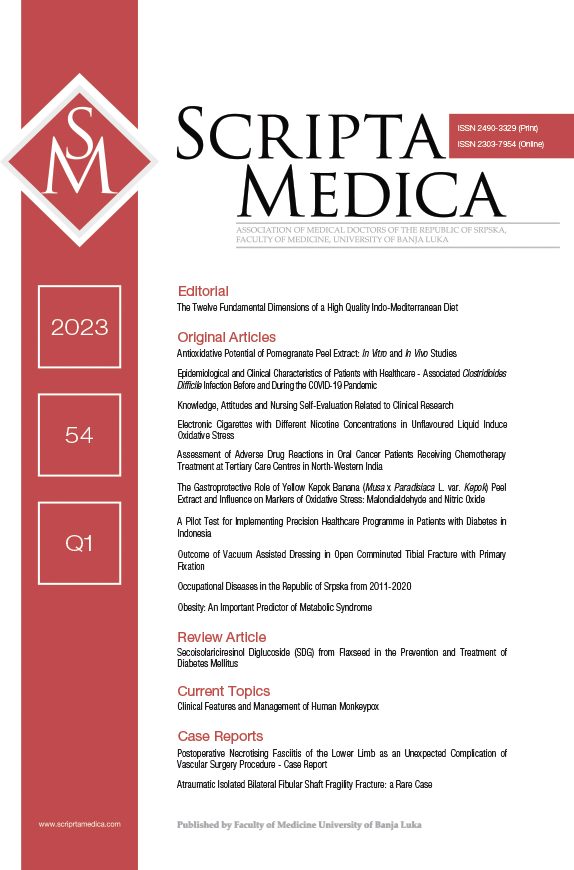Obesity: An Important Predictor of Metabolic Syndrome
Abstract
Background/Aim: The leading avoidable cause of mortality in the world is obesity. It modifies how the body reacts to insulin, which might result in insulin resistance and an elevated risk of type 2 diabetes. Recent investigations have revealed a link between obesity and the metabolic syndrome. Therefore, it was intended for the current study to look at the prevalence of obesity and how it relates to the metabolic syndrome.
Methods: 120 healthy males between 30-50 years of age were chosen from the general population of Kota district, Rajasthan, India and screened for obesity and divided in three groups: normal, overweight and obese. Each group comprised of forty subject. Serum was separated and run in department of biochemistry, GMC Kota. Anthropometric parameters were taken. The completely automated analyser ERBA EM 360 performed lipid profile and blood sugar analyses on serum.
Result: Obesity increased metabolic syndrome prevalence. In comparison to overweight and normal weight people, obese subjects exhibited considerably lower levels of high-density lipoprotein (HDL) cholesterol and significantly higher levels of blood glucose, triglycerides, total cholesterol and low-density lipoprotein (LDL) cholesterol. Additional coronary artery disease (CAD) risk prediction ratios, such as total cholesterol/HDL, LDL/HDL and triglycerides/HDL ratios that have gradually increased from the normal to obese group, show that obese subjects have a relatively higher risk of developing cardiovascular diseases (CVD) than do those in the overweight and normal groups.
Conclusion: One of the key elements of metabolic syndrome, which is a collection of clinical and metabolic anomalies including abdominal obesity, insulin resistance, hypertension and dyslipidaemia, is obesity. Each of these conditions raises the risk of CVD and diabetes mellitus type 2 directly. The progression towards diabetes and CVD can be prevented by lifestyle modification programmes and regular health checks (to explore the risk factors of metabolic syndrome).
References
1. Lau DC, Douketis JD, Morrison KM, Hramiak IM, Sharma AM, Ur E. 2006 Canadian clinical practice guidelines on the management and prevention of obesity in adults and children [summary]. CMAJ 2007 Apr 10;176(8):S1-13.
2. Shoelson SE, Herrero L, Naaz A. Obesity, inflammation and insulin resistance. Gastroenterology 2007;132(6):2169-80.
3. Lichtenstein AH, Appel LJ, Brands M, Carnethon M, Daniels S, Franch HA, et al. Diet and lifestyle recommendations revision 2006: a scientific statement from the American Heart Association Nutrition Committee. Circulation 2006;114(1):82-96.
4. Furukawa S, Fujita T, Shimabukuro M, Iwaki M, Yamada Y, Nakajima Y, et al. Increased oxidative stress in obesity and its impact on metabolic syndrome. J Clin Invest 2004;114(12):1752-61.
5. Kuhn MA. Oxygen free radicals and antioxidants: An overview of how antioxidants protect the body from disease. Am J Nurs 2003;103(4):58-62.
6. McDermott JH. Antioxidant nutrients: current dietary recommendations and research update. J Am Pharm Assoc (Wash) 2000;40(6):785-99.
7. Wilson JN, Pierce JD, Clancy RL. Reactive oxygen species in acute respiratory distress syndrome. Heart Lung 2001;30(5):370-5.
8. Gutteridge JM, Mitchell J. Redox imbalance in the critically ill. Br Med Bull 1999;55(1):49-75.
9. Diaz MN, Frei B, Vita JA, Keaney JF, Jr. Antioxidants and atherosclerotic heart disease. NEJM 1997;337(6):408-16.
10. Lissner L, Lindroos AK, Sjöström L. Swedish obese subjects (SOS): an obesity intervention study with a nutritional perspective. Eur J Clin Nutr 1998;52(5):316-22.
11. Laclaustra M, Corella D, Ordovas JM. Metabolic syndrome pathophysiology: The role of adipose tissue. Nutr Metab Cardiovasc Dis 2007;17(2):125-39.
12. Mittra S, Bansal VS, Bhatnagar PK. From a glucocentric to a lipocentric approach towards metabolic syndrome. Drug Discov Today 2008;13(5-6):211-8.
13. Hansel B, Giral P, Nobecourt E, Chantepie S, Bruckert E, Chapman MJ, et al. Metabolic syndrome is associated with elevated oxidative stress and dysfunctional dense high-density lipoprotein particles displaying impaired antioxidative activity. J Clin Endocrinol Metab 2004;89(10):4963-71.
14. Ford ES. Intake and circulating concentrations of antioxidants in metabolic syndrome. Curr Atheroscler Rep 2006;8(6):448-52.
15. Cardona F, Tunez I, Tasset I, Murri M, Tinahones FJ. Similar increase in oxidative stress after fat overload in persons with baseline hypertriglyceridemia with or without the metabolic syndrome. Clin Biochem 2008;41(9):701-5.
16. Skalicky J, Muzakova V, Kandar R, Meloun M, Rousar T, Palicka V. Evaluation of oxidative stress and inflammation in obese adults with metabolic syndrome. Clin Chem Lab Med 2008;46(4):499-505.
17. Sjogren P, Basu S, Rosell M, Silveira A, de Faire U, Vessby B, et al. Measures of oxidized low-density lipoprotein and oxidative stress are not related and not elevated in otherwise healthy men with the metabolic syndrome. Arterioscler Thromb Vasc Biol 2005;25(12):2580-6.
18. Bays HE, González-Campoy JM, Bray GA, Kitabchi AE, Bergman DA, Schorr AB, et al. Pathogenic potential of adipose tissue and metabolic consequences of adipocyte hypertrophy and increased visceral adiposity. Expert Rev Cardiovasc Ther 2008;6(3):343-68.
19. Baynes JW, Thorpe SR. Role of oxidative stress in diabetic complications: a new perspective on an old paradigm. Diabetes 1999;48(1):1-9.
20. Evans JL, Goldfine ID, Maddux BA, Grodsky GM. Are oxidative stress-activated signalling pathways mediators of insulin resistance and beta-cell dysfunction? Diabetes 2003;52(1):1-8.
21. Evans JL, Maddux BA, Goldfine ID. The molecular basis for oxidative stress-induced insulin resistance. Antioxid Redox Signal 2005 Jul-Aug;7(7-8):1040-52.
- Authors retain copyright and grant the journal right of first publication with the work simultaneously licensed under a Creative Commons Attribution License that allows others to share the work with an acknowledgement of the work's authorship and initial publication in this journal.
- Authors are able to enter into separate, additional contractual arrangements for the non-exclusive distribution of the journal's published version of the work (e.g., post it to an institutional repository or publish it in a book), with an acknowledgement of its initial publication in this journal.
- Authors are permitted and encouraged to post their work online (e.g., in institutional repositories or on their website) prior to and during the submission process, as it can lead to productive exchanges, as well as earlier and greater citation of published work (See The Effect of Open Access).

